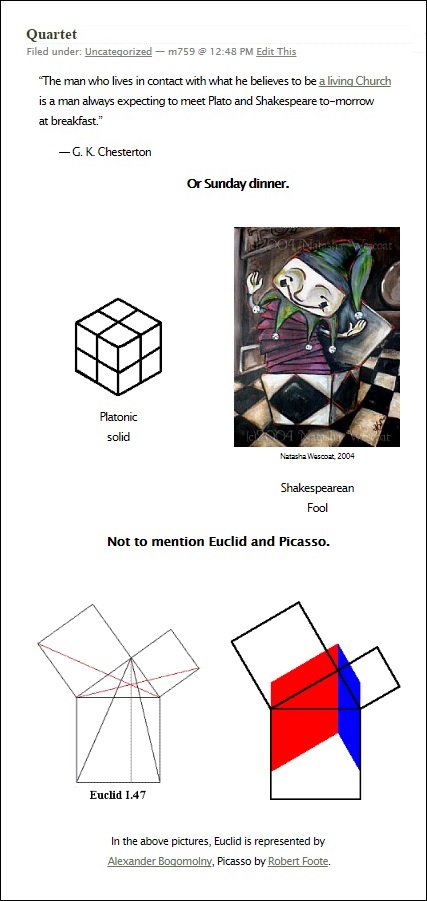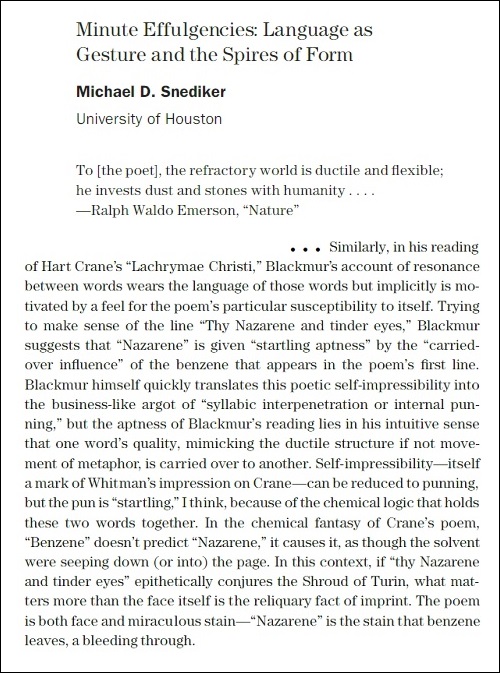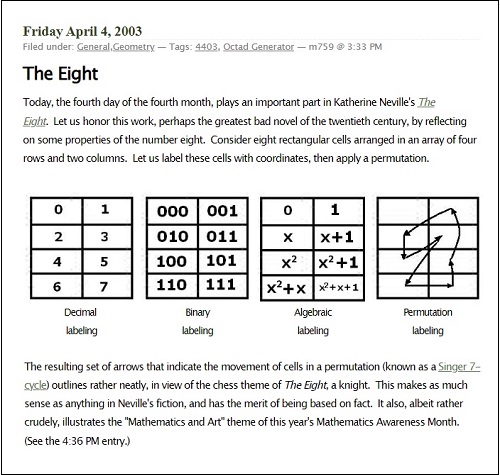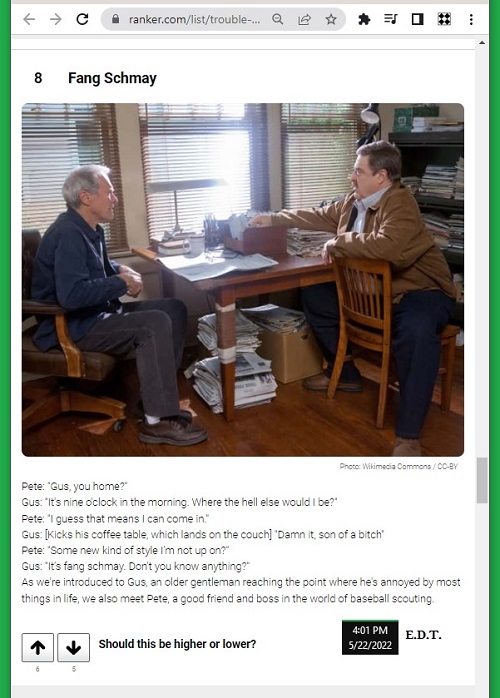
Thursday, October 12, 2023
Friday, January 13, 2023
The Not-So-Hidden Figure
LMS Gresham
|
Posted on 13/01/2023 by Peter Cameron My last major job at Queen Mary University of London more than ten years ago was designing and presenting a new first-semester first-year module to be taken by all students on mathematics programmes or joint programmes involving mathematics. I discussed it in my LMS-Gresham lecture. |
LMS

Gresham
"… seeds having fallen on barren rock, as it were" . . .
Darkness at Noon: Game of Stones*
The “Diamond Space” of Mazzola

The Source —

Some similar notions from my own work . . .
The "Digraph" of Mazzola might correspond to a directed graph
indicating the structure of a permutation, as at right below —
Mazzola's "Formula" might correpond to a matrix and translation that
transform the above "Space" of eight coordinates, and his "Gesture"
to a different way of generating affine transformations of that space . . .
as in my webpage "Cube Space, 1984-2003."
Dürer, Music, and Doktor Faustus
The previous post and Mann's Doktor Faustus in this journal
suggest a look at . . .
Wednesday, June 1, 2022
The Yearning
"… every sufficiently good analogy is yearning to become a functor."
— John Baez, 2004: "Lessons from Topological Quantum Field Theory"
Related images — Quoting scripture at The Master's University
on Jan. 31, 2017 —
… and some images (re)posted here on that same date — Jan. 31, 2017:

A related analogy — Between (1) and (2) below —
-
A right triangle A as the sum of two smaller,
inner, right triangles B and C, each similar to A . -
The square on the longest side of A as the sum
of the squares on the longest sides of B and C.
Exercise for Baez fans: Express the above analogy as a functor.
Tuesday, May 31, 2022
A Serious Pursuit
A Mad Night’s Work*
Last night's posts on triangles, and today's anniversary of the
death of Evariste Galois, suggest a review . . .
"Take triangles, perhaps" . . . as a category.
And then . . . take squares, perhaps, as another category,
and then . . . find a suitable "translation machine."
See "Square Triangles."
* Title adapted from a 2001 essay by Pierre Cartier.
Sunday, May 29, 2022
Night Hunt
Monday, May 23, 2022
Church Socials: Class Act*
* Alternate title:
"Time Is a Weapon,
or 4:45 Meets 8:38."
Sunday, May 22, 2022
“Church Socials”* Continues . . .
Social Physics
From The Washington Post yesterday —
|
"Ben Roy Mottelson, an American-born physicist who shared the Nobel Prize for a groundbreaking explanation of the structure and behavior of the atomic nucleus, including its shape, its rotations and its oscillations, died May 13. He was 95. . . . . Knowledge of nuclear structure is regarded as vital in weapons research, power generation and in solving the problems of astrophysics and the history of the universe. In what is still regarded as one of the crowning achievements of nuclear physics, Dr. Mottelson helped show, using arguments and techniques from quantum theory, how each individual constituent of the nucleus — each proton and each neutron — exerted an effect on the properties and character of the nucleus as a whole. And vice versa." . . . . — By Martin Weil, May 21, 2022, at 4:04 p.m. EDT |
From this journal on Friday the 13th of May —
"In magic, the will unites with the intellect in an
impassioned desire for supersensible knowledge.
This is the intellectual, aggressive, and scientific
temperament trying to extend its field of consciousness
[…] (Underhill 84; see also 178ff.)"
The reference above is to Underhill, Evelyn:
Mysticism: A Study in the Nature and Development
of Man’s Spiritual Consciousness.
New York: Dutton, 1911.
Social Geometry
Cannes Film Festival news in Variety yesterday —
"Östlund was last at Cannes with “The Square” in 2017, which
won the Palme d’Or. While there are many films left in competition
to screen, the reaction to “Triangle of Sadness” hints that
it could be a contender for one of the Cannes prizes."
“Triangle of Sadness” … takes its name from a fashion-world term for
the deep-V crease that appears between one’s eyebrows with stress
or age. Nothing a little Botox can’t fix."
For geometry of less social interest, see Friday's post "Squares to Triangles."
Friday, May 13, 2022
Annals of Numerology: Zero Dark 56
The above title is a reference to the time of the previous post.
Nightmare Alley fans may enjoy . . .
Those who prefer pure mathematics to entertainments of this sort
may meditate on the geometric properties of the number 56.
“Program or Be Programmed” continues . . .

Byron Gogol's "Dutton" remark suggests a search for that term
in this journal. That search, and tonight's previous post, suggest
a passage on magic and mysticism published by Dutton in 1911 —
"The fundamental difference between the two is this:
magic wants to get, mysticism wants to give […]
In mysticism the will is united with the emotions in
an impassioned desire to transcend the sense-world
in order that the self may be joined by love to
the one eternal and ultimate Object of love […]
In magic, the will unites with the intellect in an
impassioned desire for supersensible knowledge.
This is the intellectual, aggressive, and scientific
temperament trying to extend its field of consciousness
[…] (Underhill 84; see also 178ff.)"
The reference above is to Underhill, Evelyn:
Mysticism: A Study in the Nature and Development
of Man’s Spiritual Consciousness.
New York: Dutton, 1911.

















